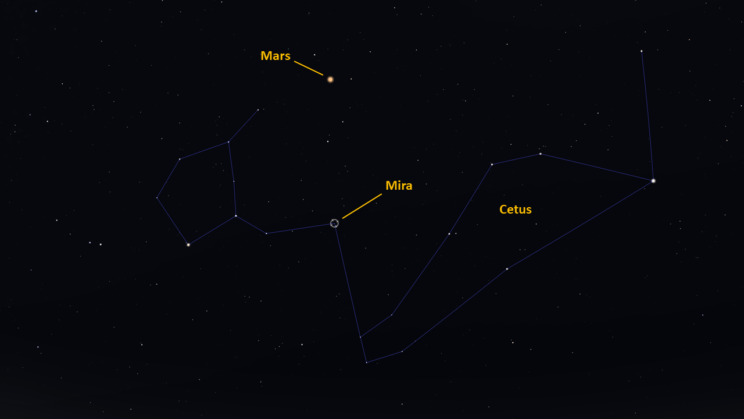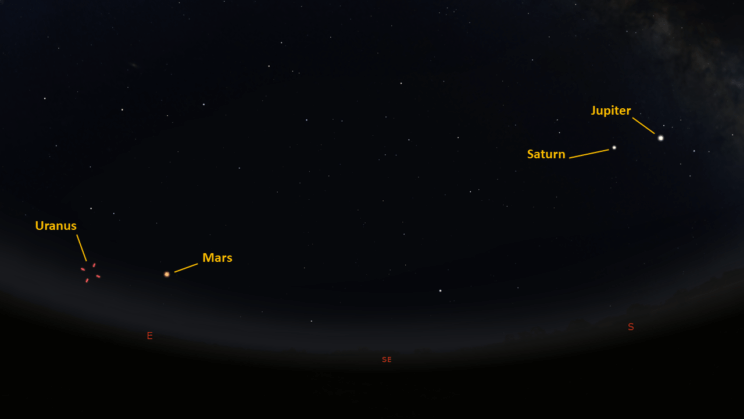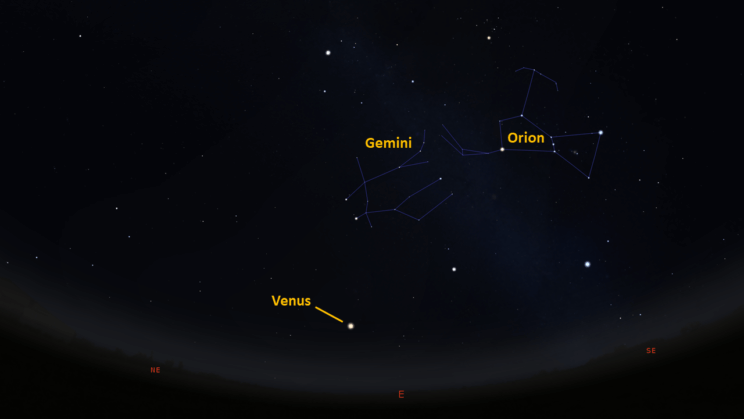This is the Saint Louis Science Center’s NIGHT SKY UPDATE for the week of Friday, September 18, 2020.
Information updated weekly or as needed.
Times given as local St. Louis time (CDT). For definitions of terminology used in the night sky update, click the highlighted text.
Public Telescope Viewings
Star parties at the Saint Louis Science Center have temporarily been canceled due to recommendations from the CDC regarding COVID-19. All public telescope events are canceled until further notice. As conditions change, we will reevaluate and update this article once public observing events resume.
Observing Highlight of the Week

Constellation Cetus and Variable Star Mira September 18, 2020
Credit: Stellarium, EG
In the constellation Cetus there is a red giant star named Mira. Mira is a famous variable star that fluctuates in magnitude over a long period of 332 days. It is the prototype for Mira-type variable stars which are periodic red giants with periods that range from 80 – 1000 days. The cause of Mira’s variability is intrinsic changes that cause the star to puff up and then shrink. During this process, the star’s temperature and luminosity will change. Mira’s variance in magnitude is about 10.3 to 2.0 magnitude. For most of this cycle Mira is too faint to see with the unaided eye.
The maximum magnitude of Mira’s period varies each year. In 2019, Mira peaked around 2.8 magnitude. Most years, Mira peaks around 3rd magnitude. Mira’s next maximum is predicted to occur on October 6.
To find Mira, you need to find the constellation Cetus. On star charts you may find this star marked as Mira or Omicron Ceti. This year Mars acts as a convenient guide to help you find Mira. Mars is found about 12° north of Mira right now. If using binoculars, Mira will be found about two binocular fields south of Mars. Remember though, Mars is a planet and as such will move amongst the star field. Each night you look for Mira you will need to update the maps you use. To learn more about variable stars visit the AAVSO.
The Sun and Moon

The Moon as seen from the International Space Station, on July 31, 2011.
Credit: NASA
Sunrise is at 6:46 a.m. on Friday, September 18 and sunset is at 7:04 p.m. providing us with about 12 hours and 20 minutes of daylight. Even after sunset, the light from the Sun will dimly illuminate our sky for about 1 hour and 30 minutes. This period is called twilight, which ends around 8:33 p.m. this week. For those with a sundial, local noon occurs around 12:55 p.m. this week.
| Day | Sunrise | Sunset |
|---|---|---|
| 2020-09-18 | 6:46 a.m. | 7:04 p.m. |
| 2020-09-19 | 6:47 a.m. | 7:02 p.m. |
| 2020-09-20 | 6:48 a.m. | 7:00 p.m. |
| 2020-09-21 | 6:48 a.m. | 6:59 p.m. |
| 2020-09-22 | 6:49 a.m. | 6:57 p.m. |
| 2020-09-23 | 6:50 a.m. | 6:56 p.m. |
| 2020-09-24 | 6:51 a.m. | 6:54 p.m. |
| 2020-09-25 | 6:52 a.m. | 6:52 p.m. |
| 2020-09-26 | 6:53 a.m. | 6:51 p.m. |
Autumnal Equinox 2020
This year the autumnal equinox occurs on September 22, 2020. This marks the beginning of fall and the time when days grow shorter and nights longer. On this day, the Sun will appear in the constellation Virgo marking one of two times each year the Sun appears to cross the celestial equator. The fall is a great time to look for a phenomenon called Zodiacal Light. This light display is often called the false dawn because during fall months a bright wedge of light appears on the eastern horizon a few hours before sunrise. The wedge of light is the result of sunlight reflecting off interplanetary dust in the solar system.
Moon
Moonrise for Friday, September 18 occurs at 8:00 a.m. and moonset will occur at 20:13 p.m. On Friday, September 18 the Moon will exhibit a waxing crescent phase with about 3% of the lunar disk illuminated. First quarter moon occurs on September 23 at 8:55 p.m.
International Observe the Moon Night
International Observe the Moon Night occurs this year on Saturday, September 26. On this day, the Moon will exhibit a waxing gibbous phase with 78% of the lunar disk illuminated. Lunar observers around the world will participate in celebrating and observing the most familiar object in the sky.
There are numerous ways to observe the Moon. Traditionally, we would encourage people to go out and look at the Moon. It is one of the best objects to see through binoculars or a telescope. If you do not have these instruments, no worries your eyes will work fine too. Aside from these methods NASA has put together a list of 10 ways to enjoy the Moon, you can find this list here. You can also learn more about International Observe the Moon Night here.
International Space Station (ISS) Observing

Visible passes of ISS from St. Louis for the week of September 18 occur during evening hours. The best passes this week occur on September 18 and 19. Use the table below for information about these and other visible passes this week.
Catch ISS from St. Louis starting Friday, September 18
| Date | Starts | Max. altitude | Ends | |||||||
|---|---|---|---|---|---|---|---|---|---|---|
| Time | Alt. | Az. | Time | Alt. | Az. | Time | Alt. | Az. | ||
| 18 Sep | -2 | 20:49:01 | 10 | W | 20:52:02 | 30 | NNW | 20:53:13 | 23 | N |
| 19 Sep | -2.8 | 20:01:17 | 10 | WSW | 20:04:32 | 47 | NW | 20:07:49 | 10 | NE |
| 20 Sep | -1.1 | 20:52:10 | 10 | WNW | 20:54:20 | 16 | NNW | 20:55:45 | 13 | N |
| 21 Sep | -1.4 | 20:04:03 | 10 | WNW | 20:06:43 | 21 | NNW | 20:09:22 | 10 | NNE |
| 23 Sep | -0.9 | 20:07:29 | 10 | NW | 20:09:04 | 13 | NNW | 20:10:38 | 10 | NNE |
| 24 Sep | -1.1 | 19:19:11 | 10 | WNW | 19:21:21 | 16 | NNW | 19:23:31 | 10 | NNE |
Magnitude (Mag): The Measure of brightness for a celestial object. The lower the value is, the brighter the object will be.
Altitude (Alt): The angle of a celestial object measured upwards from the observer’s horizon.
Azimuth (Az): The direction of a celestial object, measured clockwise from an observer’s location with north being 0°, east being 90°, south being 180° and west being 270°.
For information about ISS flyovers and other visible satellites, visit www.heavens-above.com
Detailed information regarding all unmanned exploration of our universe, missions past, present, and planned, can be found at Jet Propulsion Laboratories:
The Visible Planets

Looking Southeast, at 9:30 pm, September 18, 2020
Credit: Stellarium, EG

Looking East, 4:00 am, September 19, 2020
Credit: Stellarium, EG
This week, four naked eye planets are visible. Jupiter and Saturn rise before sunset. Look for them in the south once it is dark. Mars rises in the evening and will be best seen around midnight. Venus can be found in the eastern sky before sunrise.
For those tracking Jupiter and Saturn as they approach their great conjunction later this year, the two gas giants currently appear about 7.9° apart in the sky. From now until December 21, Jupiter will appear closer to Saturn each night.
Venus
Venus is well into another morning apparition. After months of seeing Venus in the west after sunset Venus is now visible in the east before sunrise. Venus rises at 3:13 a.m. and will be easily seen by 4:00 a.m. Venus remains a morning object until March 26, 2021 when it reaches superior conjunction. Since Venus has passed greatest western elongation, it will start to exhibit a gibbous phase.
Mars
The red planet rises around 8:46 p.m. and will be high enough to see in the east by 10:00 p.m. Opposition for Mars occurs on October 13, 2020. As we head towards this date Mars will appear brighter and larger through a telescope improving surface details. Surface features are already visible when viewing conditions are favorable. Current apparent brightness of Mars is -2.2 magnitude. At this magnitude Mars will appear brighter than any star in the night sky.
Jupiter
Look for Jupiter in the southeast about 30 minutes after sunset. Jupiter will set at 1:19 a.m. Those with a telescope can enjoy views of Jupiter’s cloud features and the Great Red Spot when it is pointed towards Earth.
Saturn
Look for the ringed planet in the southeast about 30 minutes after sunset. Saturn sets at 1:58 a.m. For those with a telescope keep track of the orientation of Saturn’s rings. Since Saturn is tilted on its rotational axis, we cross the plane of Saturn’s ring every 13 to 15 years. We are headed towards another ring plane crossing on March 23, 2025. Over the next five years you will notice Saturn’s rings will gradually incline towards an edge on appearance.
2020 Great Conjunction
This year the planets Jupiter and Saturn will reach conjunction. A conjunction is when two or more celestial bodies share the same right ascension. For Jupiter and Saturn this astronomical event occurs every 20 years. The conjunction occurs on December 21, 2020. You will find the two planets close together in the southwest just after sunset on this date.
Visit the James S. McDonnell Planetarium for more information on what’s up!
Night Sky Update: September 18-September 26, 2020






